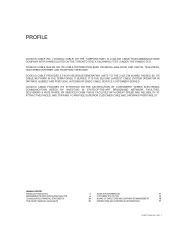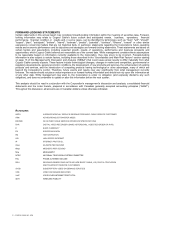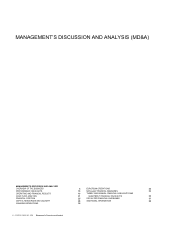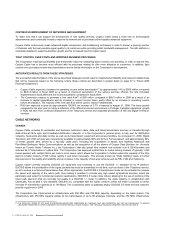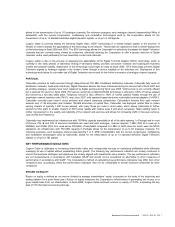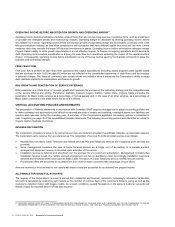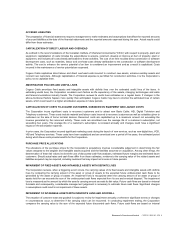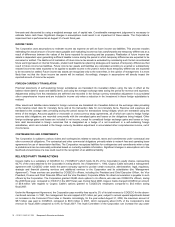Cogeco 2008 Annual Report Download - page 12
Download and view the complete annual report
Please find page 12 of the 2008 Cogeco annual report below. You can navigate through the pages in the report by either clicking on the pages listed below, or by using the keyword search tool below to find specific information within the annual report. Management’s Discussion and Analysis COGECO CABLE INC. 2008 11
certain circumstances upon request to that effect by COGECO. In addition, the Corporation reimburses COGECO’s out-of-pocket
expenses incurred with respect to services provided to the Corporation under the Management Agreement. In fiscal 2009, the
management fee will be increased, pursuant to the Management Agreement, by 3.5% to $9 million, which is equal to the increase in
the Consumer Price Index in Canada for the twelve-month period ended on August 31, 2008.
ADOPTION OF NEW ACCOUNTING STANDARDS
ADOPTED DURING FISCAL 2008
FINANCIAL INSTRUMENTS
Effective September 1, 2007, the Corporation adopted the CICA Handbook Section 1530, Comprehensive Income, Section 3855,
Financial Instruments – Recognition and Measurement, Section 3861, Financial Instruments – Disclosure and Presentation, Section
3865, Hedges and Section 3251, Equity.
Statements of comprehensive income
A new statement, entitled consolidated statements of comprehensive income, was added to the Corporation’s consolidated financial
statements and includes net income as well as other comprehensive income. Other comprehensive income represents changes in
shareholders’ equity arising from transactions and events from non-owner sources, such as changes in foreign currency translation
adjustments of net investments in self-sustaining foreign subsidiaries, long-term debt designated as a hedge of net investments in
self-sustaining foreign subsidiaries, and changes in the fair value of effective cash flow hedging instruments.
Recognition and measurement of financial instruments
Under these new standards, all financial assets, including derivatives, must be classified as available-for-sale, held-for-trading, held-
to-maturity, or loans and receivables. All financial liabilities, including derivatives, must be classified as held-for-trading or other
liabilities. All financial instruments classified as available-for-sale or held-for-trading are recognized at fair value on the consolidated
balance sheet while financial instruments classified as loans and receivables or other liabilities will continue to be measured at
amortized cost using the effective interest rate method. The standards allow the Corporation the option to designate certain financial
instruments, on initial recognition, as held-for-trading.
All of the Corporation's financial assets are classified as held-for-trading or loans and receivables. The Corporation has classified its
cash and cash equivalents as held-for-trading. Accounts receivable have been classified as loans and receivables. All of the
Corporation’s financial liabilities were classified as other liabilities, except for the cross-currency swap agreements, which were
classified as held-for-trading. Held-for-trading assets and liabilities are carried at fair value on the consolidated balance sheet, with
changes in fair value recorded in the consolidated statements of income, except for the changes in fair value of the cross-currency
swap agreements, which are designated as cash flow hedges of the Senior Secured Notes Series A and are recorded in other
comprehensive income. Loans and receivables and all financial liabilities are carried at amortized cost using the effective interest
rate method. Upon adoption, the Corporation determined that none of its financial assets are classified as available-for-sale or held-
to-maturity. Except for the treatment of transaction costs and derivative financial instruments mentioned below, the provisions of the
new accounting standards had no impact on the consolidated financial statements on September 1, 2007 and August 31, 2008.
Transaction costs
Effective September 1, 2007, transaction costs are capitalized on initial recognition and presented as a reduction of the related
financing, except for transaction costs on the revolving loan and the swingline facility, which are presented as deferred charges.
These costs are amortized over the term of the related financing using the effective interest rate method, except for transaction
costs on the revolving loan and the swingline facility, which are amortized over the term of the related financing on a straight-line
basis. Previously, all transaction costs were capitalized and amortized on a straight-line basis over the term of the related financing,
a period not exceeding five years. The impact of these adjustments at September 1, 2007 reduced deferred charges by $1.2 million,
reduced long-term debt by $3.1 million, increased future income tax liabilities by $0.6 million and increased retained earnings by
$1.3 million.
Cash flow hedge
All derivatives are measured at fair value with changes in fair value recorded in the consolidated statements of income unless they
are effective cash flow hedging instruments. The changes in fair value of cash flow hedging derivatives are recorded in other
comprehensive income, to the extent effective, until the variability of cash flows relating to the hedged asset or liability is recognized
in the consolidated statements of income. Any hedge ineffectiveness is recognized in the consolidated statements of income
immediately. Accordingly, the Corporation’s cross-currency swap agreements must be measured at fair value in the consolidated
financial statements. Since these cross-currency swap agreements are used to hedge cash flows on Senior Secured Notes Series A
denominated in US dollars, the changes in fair value are recorded in other comprehensive income. The impact of measuring the
cross-currency swap agreements at fair value on September 1, 2007, increased derivative financial instrument liabilities by
$83.5 million, decreased deferred credit presented in long-term debt by $80.2 million, decreased future income tax liabilities by


